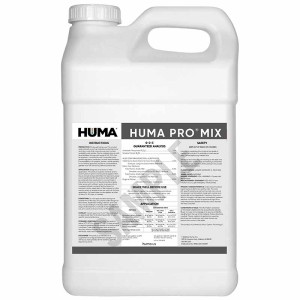PROMAX®
Benefits of Use:
- Inhibits nematode activity
- Provides excellent control of fungal diseases in soils
- Activates natural defense mechanisms in plants
- Safe for crops, humans, and the environment
- Fungicidal effect against all types of fungal spores
- Product’s natural chemistry has no documented cross-resistance
- Cost-effective performance
- Fast-acting upon contact
- Restricted Entry Interval (REI): 0 days
- Pre-Harvest Interval (PHI): 0 days
FAQs
Related Videos
Huma Crop Protection
Are pests eating up your profits? Do you need crop protection that is as safe as it is effective? Soil-applied Promax and foliar-applied Proud 3 are highly effective zero-residue products with not buffer zero
Learn More
Huma Promax: Crop Protection Product
A soil fungicide and nematicide that eliminates pests and soil-borne disease naturally. OMRI-listed organic pesticide is soil applied to kill soil pathogens and nematodes on contact. Zero residue, no buffer zone, and no re-entry
Learn More
Chili Farmer Performs Field Trials with Organic Pesticide
Chili Farmer Chip Spear of Luna County New Mexico runs field trials using Huma Gro Promax biopesticide. OMRI-listed Promax effectively treats nematodes and soil disease and is safe enough to use throughout the growing season,
Learn More
Related Products
Related Case Studies

Huma® Promax® and Zap® Decrease Charcoal Rot in Florida Strawberry, With Increased Yield and ROI of 10:1
Background Charcoal rot, caused by the soil-borne pathogen Macrophomina phaseolina, can be a significant threat to strawberry production. Two Huma® products, Promax® and Zap®, had previously been shown to be successful in managing soil-borne diseases in strawberries. Objectives The primary objectives of this study were to assess the efficacy of Promax® and Zap® in reducing

Huma® Ultra-Precision™ Blend Plus Root Dip Increases Strawberry Yields 30%
Objective The purpose of this research project was to evaluate how a special blend of fertilizer solution and a root dip made of Huma® products with Micro Carbon Technology® affect strawberry yield when compared with a control program of grower’s standard fertilizer and a competitor root dip product. Materials & Methods Strawberry cultivar San Andreas

Huma® Nutrient and Fumigation Replacement Program Increases Strawberry Yields
Objective This field trial assessed the effects on strawberry yields of replacing field fumigation with periodic applications of Huma® Promax® and Zap® and replacing a grower’s standard fertilizer program with irrigation-applied Ultra-Precision™ blended liquid Huma® crop nutrition products. Materials & Methods This trial was conducted in Arroyo Grande, Calif., using Portola strawberries planted in 40’
Related Blog Posts

The Big, the Bold, and the Bill: What BBB Means for Ag
The Big Beautiful Bill was signed into law on July 4. At 887 pages, it certainly is big. As for being beautiful, that will be in the eyes of the beholders. Like most budget bills, depending on your point of view, the contents may resemble that famous Clint Eastwood film, “The Good, The Bad, and The Ugly.” But what does BBB specifically mean for agriculture?

This Week in Ag #56
We’re all a wee bit Irish come Sunday, even if your family tree has no roots in the Emerald Isle. And no holiday is more linked to a particular plant than St. Patrick’s Day is to the shamrock (which is actually a white clover). The relationship’s origins trace back 16 centuries ago, when the future Patron Saint

BHN Assists St Vincent de Paul Mesa Urban Farm
[et_pb_section bb_built=”1″][et_pb_row][et_pb_column type=”4_4″][et_pb_text _builder_version=”3.8″] The Society of St. Vincent de Paul (SVDP)—with its mission of Feed, Clothe, House, Heal—does a lot of work for the poor and homeless in the Greater Phoenix area, and their many projects include several urban farms that are in proximity to their free dining rooms. As with most of their







